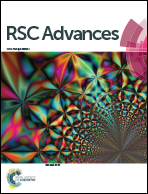Thermoresponsive magnetic ionic liquids: synthesis and temperature switchable magnetic separation†
Abstract
Thermoresponsive magnetic ionic liquids (MILs) with lower critical solution temperature (LCST) below 60 °C are synthesized. Magnetic separation of MILs from aqueous solution at temperatures above LCST is demonstrated.


 Please wait while we load your content...
Please wait while we load your content...